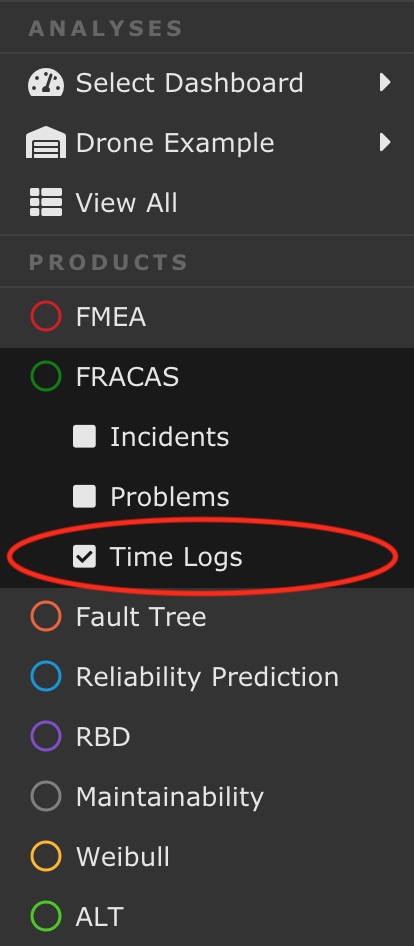Using FRACAS Time Logs
Using Time Logs is not required unless you want to compute failure and repair metrics in Relyence FRACAS. If you do not want to use the Time Log feature, you can turn it off in FRACAS Properties.
To access Time Logs, select Time Logs in the Sidebar menu when Relyence FRACAS is active.

The Time Log Table appears.

In the Time Log Table, enter the operating time information for the products or systems that are currently deployed. Using the example above, from the FRACAS Example Analysis, there are 6 Time Logs entered. The first Time Log indicates that from July through December of 2016, there were 50 drones operating 50% of the time. This correlates to 2196 Active Hours per Unit, for 109800 Total Active Hours. Relyence FRACAS computes the Active Hours per Unit and Total Active Hours automatically based on the Dates, Number of Units, and Duty Cycle you enter. If you prefer, you can enter these values directly.
If you have units that are continuously operational, you can select No End Date for that Time Log and Relyence FRACAS will use today's date at the End Date when performing MTBF calculations.
If Time Log information is not complete or is inconsistent, Relyence will use default assumptions to compute the failure metrics. In this case, a message will appear in the FRACAS Calculation Results dialog: "To more accurately calculate FRACAS metrics, model your entire Incident capture time frame with Time Logs." For more details on the specific issue, click the blue information icon that appears by the message.
To see how Time Logs affect your metrics, try out the following:
1. Calculate and note the failure rates, MTBFs, and trend scores using the Example without any modifications.
2. Add a Time Log for last month with Number of Units = 100 and Duty Cycle = 50.
3. Recalculate and note the new results.
You will notice that the failure rate is lower, the MTBF is higher, and the trend scores have improved. The failure rate corresponds to the number of failures over a time period. Because there is the same number of failures (reported Incidents) in a longer time period, the failure rate has decreased. MTBF is the average number of hours expected between failures. Because there is the same number of failures in a longer time period, the time between failures increases. Because units have more operational time without more incidents, the trend score reflects an improvement.